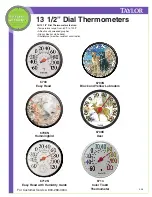
9
example, you are moving between rooms with different temperatures.
This system, too, enables the thermometer to take sufficiently accurate readings.
In this case, “MQCS” appears on the display indicating that manual quick calibration
has been performed.
The MQCS is possible only if the room temperature is in the 10,0-45,0°C (50.0-
113.0°F) temperature range.
9. REPLACING the BATTERIES
• Set your thumb in the oval hollow on the back of the unit, press down and slide the
battery hatch out as shown in fig. 10.
• Remove the battery hatch.
• Remove the old batteries and dispose of them
as required in the containers provided for this
purpose.
• Insert 4 new AAA - LR03 batteries, preferably
alkaline, carefully complying with the position in-
dicated in their housing.
• To close the hatch, slide it in the opposite direction from which it was opened.
• After changing the batteries, let the thermometer stabilize for 20 minutes before
taking a temperature reading, or run a manual quick calibration (MQCS, par. #8).
• Remove the batteries if you do not expect to use the thermometer for a long
time.
10. CLEANING
CLEANING THE WAVEGUIDE: the thermometer waveguide (fig. 1) is very delicate and
must be kept clean. Store the device in a dry, clean place, away from dust. However, if
you need to remove dust or dirt from the waveguide or sensor at its base, use a cotton
swab that has been slightly dampened with alcohol.
Remove all dirt and make certain that nothing accumulates at the bottom of the wave-
guide where the sensor is located. Do not use any other objects or liquids as the sur-
face of the sensor could easily be scratched or damaged. Never let any excess liquid
penetrate into the waveguide and sensor.
CLEANING THE THERMOMETER BODY: use a soft cloth dampened with soap and
water and possibly re-wipe with a sodium hypochlorite disinfectant.
DO NOT USE the thermometer for at least 30 minutes after cleaning.
Fig.
10
Close
Open




































